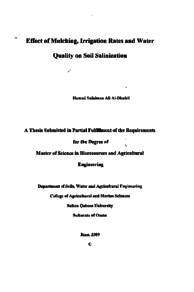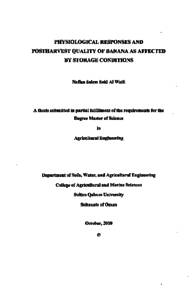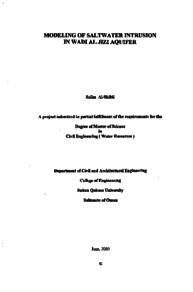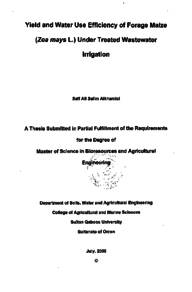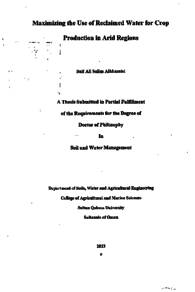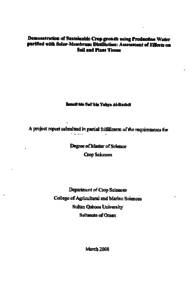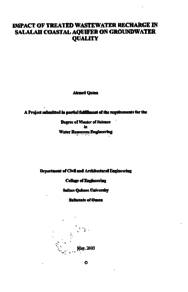Document
Effect of mulching, irrigation rates and water quality on soil salinization
Publisher
Sultan Qaboos University
Gregorian
2009
Language
English
Subject
English abstract
Sultanate is categorized as arid country with low rainfall and high evapo transpiration (ET). Ground water is the main source of water for both domestic and agriculture use. High water demand has led to over pumping and prolonged lack of rains has reduced the extent of recharge. This situation has progressively deteriorated the quality of both water and soil towards salinity. The affected areas are mostly the farms near the coast, which have abundant but saline water. Hence, the use of salir water cannot be avoided. Therefore, it is needed that such management practices be devised which ensure sustainable use of saline water with minimum loss to crop yields and least threat to soil health.
This experiment was conducted during summer 2007 at Agricultural Research Center, Directorate General of Agricultural & Livestock Research in Rumais to evolve some practicable and economical management practices, which can mitigate the potential deleterious effects of saline waters to plants and soil. A split block design was applied with 3 factors (Irrigation rates, water salinity and mulch) and 3 replicates. Two categories of irrigation water (EC 3 & 6 d S/m), three level of irrigation quantities (100%, 120% & 140% of ETC), two management practices (Plastic sheet and crop residues mulch=date palm leaves) vs. control, and their interaction on soil EC, plant parameters and yield were investigated. Sorghum forage crop was grown. Moisture percentage and soil temperature underneath different mulches were monitored throughout the experiment.
The results revealed that increasing amounts of irrigation water from 100% to 120% and 140% of ETC increased yields by 20 and 25% (from 47 to 57, and 59 ton/ha) respectively, Data of the experiment indicated that 6 ds/m decreased green forage yield (52 t/ha) compared with 3 dS/m (56.5 t/ha) but also increased soil EC significantly. However, the plastic sheet and crop residue mulch proved greatly helpful to control the bad effects of saline water on crop yield and soil EC. The positive effects of both the treatments were found to be significant over control (No management practice). Date palm leaf mulch proved superior in crop yield. The recorded green yields for date palm mulch, plastic mulch and control were: 58.7, 52.7 and 51.9 tha respectively that were assessed as significant statistically. Both type of mulches proved successful in controlling increase in soil EC and keeping it as 2.7dS/m as against 3.6 dS/m for control. Another benefit of date palm mulch was observed in keeping the soil cool when compared with control as well as plastic mulch. The recorded respective mean temperatures were; 33.2, 34.0 and 35.4. Date palm mulch also proved useful in conserving the moisture and means determined values were 16.5, 14.9 and 14.8 % for date palm mulch, plastic mulch and control respectively.
The effect of Gonu cyclone was also studied. No permanent effect on soil moisture and temperature was recorded but soil EC decreased considerably. Plant parameters remained un-affected with cyclone event.
Member of
Resource URL
Arabic abstract
تعتبر السلطنة ضمن الدول الجافة التي تعاني من شح في معدلات الأمطار مع ارتفاع في معدلات التبخر. وتشكل المياه الجوفية المصدر الرئيسي سواء للاستخدامات المنزلية والزراعية والصناعية، وادي الطلب المستمر للمياه إلى الإفراط في ضخ المياه الجوفية والذي أدى إلى تدني نوعية المياه نتيجة تداخل مياه البحر مع مياه الآبار في المناطق الساحلية . هذا بدوره أدى إلى تملح التربة وموارد المياه ، أن الحاجة إلى استخدام تلك المياه المتملحة يتطلب إيجاد عدد من الإدارة التطبيقية للحصول على زراعة مستدامة بأقل فاقد من المحصول والتقليل من مخاطر التملح.
اجريت هذه الدراسة في المزرعة الرئيسية بالمديرية العامة للبحوث الزراعية والحيوانية بالرميس وذلك الدراسة مدى تأثير الإدارة التطبيقية على الملوحة الثانوية، تم زراعة محصول الذرة الرفيعة صنف سوبر دان تحت تأثير استخدام التغطية بالبلاستيك ومخلفات النخيل بالمقارنة مع الشاهد (بدون تغطية) مع استخدام ثلاث مستويات من الري المضاف (۱۰۰% و ۱۲۰% و 140% من البحر والفتح المرجعي) وتحت نوعين من ملوحة مياه الري ۳ و ۹ دیسیسمن للمتر وذلك في شهر مارس لعام ۲۰۰۷.
توضح النتائج تفوق التغطية بمخلفات النخيل عن التغطية بالبلاستيك على زيادة المحصول معنويا بنسبة ۱۳ % - ۲ % مقارنة بالشاهد، علاوة على تفوق التغطية بمخلفات النخيل في الاحتفاظ بنسبة أكبر من رطوبة التربة مع معدلات حرارة أقل ودرجات أقل من ملوحة التربة ، وكذلك أوضحت النتائج أن الري بمعدل ۱۲۰% من البخر والنتح المرجعي أدى إلى زيادة بالمحصول بنسبة ۲۰ %و عند الري بمعدل 140% من البحر والنتح المرجعي ترتفع نسبة الزيادة بالمحصول إلى ۲۰% مقارنتا باستخدام الري بمعدل ۱۰۰% من البخر نتح المرجعي. كما توضح النتائج عدم وجود أي فروقات معنوية بالإنتاج تحت تأثير استخدام نوعين من ملوحة مياه الري ۳ و ۹ دیسیسمن للمتر.
اجريت هذه الدراسة في المزرعة الرئيسية بالمديرية العامة للبحوث الزراعية والحيوانية بالرميس وذلك الدراسة مدى تأثير الإدارة التطبيقية على الملوحة الثانوية، تم زراعة محصول الذرة الرفيعة صنف سوبر دان تحت تأثير استخدام التغطية بالبلاستيك ومخلفات النخيل بالمقارنة مع الشاهد (بدون تغطية) مع استخدام ثلاث مستويات من الري المضاف (۱۰۰% و ۱۲۰% و 140% من البحر والفتح المرجعي) وتحت نوعين من ملوحة مياه الري ۳ و ۹ دیسیسمن للمتر وذلك في شهر مارس لعام ۲۰۰۷.
توضح النتائج تفوق التغطية بمخلفات النخيل عن التغطية بالبلاستيك على زيادة المحصول معنويا بنسبة ۱۳ % - ۲ % مقارنة بالشاهد، علاوة على تفوق التغطية بمخلفات النخيل في الاحتفاظ بنسبة أكبر من رطوبة التربة مع معدلات حرارة أقل ودرجات أقل من ملوحة التربة ، وكذلك أوضحت النتائج أن الري بمعدل ۱۲۰% من البخر والنتح المرجعي أدى إلى زيادة بالمحصول بنسبة ۲۰ %و عند الري بمعدل 140% من البحر والنتح المرجعي ترتفع نسبة الزيادة بالمحصول إلى ۲۰% مقارنتا باستخدام الري بمعدل ۱۰۰% من البخر نتح المرجعي. كما توضح النتائج عدم وجود أي فروقات معنوية بالإنتاج تحت تأثير استخدام نوعين من ملوحة مياه الري ۳ و ۹ دیسیسمن للمتر.
Category
Theses and Dissertations

